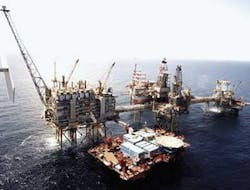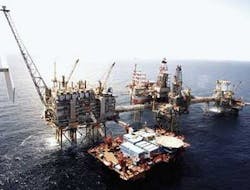Phillips planning NKr 5.4-billion production upgrade for Ekofisk
Nick Terdre
Contributing Editor
Having implemented a second stage of development on the giant Ekofisk field in 1998, Phillips Petroleum Co. Norway is now embarking on a third stage in its Ekofisk growth project.
A plan for development and operation is due to be submitted in November and should be approved in early 2003. Start-up could follow as early as 2005.
Phillips declines to talk about the project, but details are available in plans for an environmental and social impact analysis that it submitted recently to the Ministry of Petroleum and Energy.
In it the company explains that, "Since Ekofisk II came onstream in 1998, the work of further developing the recovery of reserves in the Ekofisk field and from the Ekofisk area has continued. The result of this work is that additional reserves can be profitably produced through more wells to drain the Ekofisk field more effectively and exploiting the flanks of the reservoir. In addition, an increase in capacity of the existing process and transport facilities will increase the producible reserves in the Eldfisk field. It is calculated that the project will increase the recoverable reserves from the Ekofisk field and the Eldfisk field by 156 MMboe. The increase in capacity will mean that the process capacity is raised to around 450,000 b/d of oil and wet gas."
The project will cost an estimated NKr 5.4 billion with NKr 2.2 billion going for a new platform and modification work and NKr 3.2 billion for the drilling program.
Over the years, Phillips has been able to increase the recovery rate of the greater Ekofisk area, where the currently producing fields are Ekofisk, Eldfisk, Embla, and Tor. In January 2002, the company estimated remaining recoverable reserves at 1.64 Bbbl of oil, 60 bcm of dry gas, and 5.6 million tons of NGLs. About 48% of oil reserves and 79% of dry gas reserves have been produced.
Since Ekofisk II was brought onstream, further debottlenecking of production facilities has taken place, with the result that production has risen to its highest levels ever, averaging 332,000 b/d oil and 11 MMcm/d gas in 2001 – equivalent to about 10% of Norway's total output. Production is currently expected to continue until 2028, when the license expires, but Phillips has indicated in the past that it could go on to nearer 2050.
The Ekofisk growth plan calls for a new wellhead platform, 2/4 M, to be installed at the field center, from which 19 new wells will be drilled in a four-year program. This is due to start in 2005, so the project will come onstream when the first of these wells comes into production, probably later in 2005. Depending on the results of the drilling program, up to 11 further wells could follow.
Various modifications will be required to the topsides facilities, to increase both production and export capacity. The platforms affected are Eldfisk 2/7 B, 2/7 A, and 2/7 FTP, and Ekofisk 2/4 J and 2/4 K. New equipment will be installed and some existing equipment upgraded. At a later stage, a power cable will be laid from 2/4 K to 2/4 J to provide more efficient power supply.
A key partner for Phillips in this work will be ABB Offshore Systems, which is performing pre-engineering for the growth project and separately was awarded the contract for maintenance and modifications on the Ekofisk area platforms. Worth an annual NKr 500 million, this contract runs for four and a half years, with three two-year options. It covers engineering, procurement, construction, installation, and commissioning and will employ some 600 workers, half offshore.
A fabrication contract for the new platform is expected to be placed shortly after approval, or possibly before. This will allow a building period of some 18 months to fit in with Phillips' intention to have the platform installed in time for offshore hook-up and commissioning to be carried out during the planned maintenance turnaround in late summer 2004.
With around 30 slots, 2/4 M will not be as large as 2/4 X, the 50-slot wellhead platform installed as part of the Ekofisk II program. Nor will it have its own drilling rig, as 2/4 X does. Instead, the wells will be drilled by a jackup unit cantilevered over the wellbay. The 19-well drilling program will last about four years.
It is presumed that all the wells on the new platform will be producers, as is the case on 2/4 X, with the exception of a cuttings injection well. Water is currently injected into the field through dedicated platforms such as 2/4 K. Water-flooding has been one of the keys to the rising rate of recovery, and Phillips is one of the sponsors of a new research center for increased oil recovery that was recently set up in Stavanger. It is also the main funder, providing two-thirds of the center's annual NKr 15-million budget.
The center's researches will initially focus on increased oil recovery techniques that can be used with or following water injection. "Research is important to increasing the recovery rate from the Ekofisk reservoirs," commented Lars Takla, managing director of Phillips Petroleum Co. Norway. "A 1% increase corresponds to 80 MMboe, which is a medium size find on the Norwegian shelf."
The company's partners in the initiative are Rogaland Research and Stavanger University College, and the plan has been enthusiastically endorsed by the Norwe-gian Petroleum Directorate, which worked closely with Phillips in pioneering water injection techniques in the 1980s.
The Ekofisk growth project forms part of Phillips' Ekofisk 2010 vision. The vision coordinates and provides an overall focus for the various projects and activities aimed at achieving an optimal utilization of oil and gas reserves in the Ekofisk area in an environmentally-friendly manner. One initiative that comes under this umbrella is a project to reinject all produced water, which is relevant to the growth project, given the increased volume of produced water that can be expected as production capacity is boosted.
Further field development may also be coming in the Ekofisk area, though it is not mentioned in the plans for the impact study. However, Phillips is understood to be mulling the redevelopment of Ekofisk West and the Tjalve field, which lies near Tor, to produce the gas reserves. Ekofisk West was shut-in in 1998 when Ekofisk II was implemented. Ekofisk West could be developed with subsea wells, which would be Phillips' first in the area.

